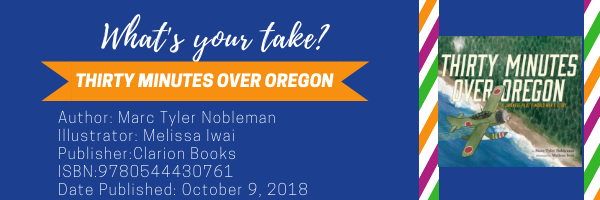by Holly Johnson, University of Cincinnati and Marilyn Carpenter, Professor Emeritus, Eastern Washington University
This month, Holly and Marilyn discuss four picture books focused on the theme of kindness. In multiple circumstances, kindness is always an alternative, and perhaps the only realistic alternative for survival. In the first installment of April’s MTYT, Thirty Minutes Over Oregon: A Japanese Pilot’s World War II Story, provides another perspective on history that does not always seem kind.
MARILYN: I remember visiting Oregon when I was a kid and the stories of blackouts. I heard about the provisions people took in their coastal homes to protect themselves from Japanese bombings during World War II. However, when I visited friends and relatives in the state, I never heard about the account seen in this book in which a Japanese submarine gets close enough to the mainland to launch a plane by catapult and recover it. The mission of that single plane and its pilot was to bomb the Oregon forest, hoping to set it on fire. Thankfully the bombing mission was not successful. However, it was the only bombing of the U.S. Mainland during WWII and it happened twice! But what really stands out to me is that in the years after the war, the Japanese pilot and the people of Brookings, the small town closest to the bombing site, visited each other and built bridges of peace between the two countries. What do you think, Holly? Had you ever heard this story?
HOLLY: This story surprised me! I did not know that aspect of history, and I wonder how many others lacked this knowledge. In many ways, it gives me a whole new perspective on our vulnerability as a nation during WWII. Now, with the advancement of weaponry around the world, we see that vulnerability on the nightly news. I can only imagine what might would have happened if people knew about this when it occurred. Our nation had already panicked and placed thousands of Japanese Americans in internment camps. History is so interesting, because it makes us reflect. While we might think we are much more sophisticated than our historical predecessors, we are simply part of the ongoing process of life and the cosmic story. I wonder what will the future generations think of us. What does this book make you think of in respect to history, Marilyn?
MARILYN: This non-fiction book proves once again that history is amazing, and it is impossible to know all of it. The unique historical account in this book enlarges our perceptions and understandings in deeper ways. To me, the most important part of the story is the pilot and the people of Brookings come to new cultural understandings. The pilot even donates money to the town library to purchase books about other cultures. His kindness inspires the people of the town to also reach out to their previous enemy. The pilot welcomes high school students from Brookings to visit him in Japan. Finally, when he dies, part of his ashes are scattered in Brookings. Even enemies can come together through kindness. What will you remember about this book, Holly?
HOLLY: I will remember the audacity of the pilot during the war. Or perhaps it is his fearlessness and sense of duty. He did a truly frightening thing for himself and for those in Oregon. The precariousness of the town and people’s lives strike me. The bomb could have been disastrous. I wonder about how those “everyday” Americans might have felt if the mission had succeeded. And, of course, the lives of all those who live in war-torn countries are so precarious. One moment people are living their lives, and then suddenly the very foundation of their world is destroyed. We all face this possibility given the ability of many nations to produce weapons of mass destruction. It is so much better to think about kindness.
Title: Thirty Minutes Over Oregon: A Japanese Pilot’s World War II Story
Author: Marc Tyler Nobleman
Illustrator: Melissa Iwai
ISBN: 9780544430761
Publisher: Clarion Books
Publication Date: October 9, 2018
This is the first installment of April’s MTYT. Next week, Holly and Marilyn will talk about a book that brings ideas of destruction and kindness together. Check out this second installment here.
- Themes: Holly Johnson, Marc Tyler Nobleman, Marilyn Carpenter, Melissa Iwai, Thirty Minutes Over Oregon
- Descriptors: My Take/Your Take


I read this story with interest for my family experienced and lived through the bombing of Pearl Harbor and the years of war that followed this terrible event.
I would like to point out that NOT ONLY did soldiers die, but so did CIVILIANS, the locals who LIVED this WAR on a DAILY BASIS.
My mother told me that there were planes flying overhead all the time so no one noticed. When she heard on the radio that Pearl Harbor was bombed, she stepped outside and saw CIVILIAN BODY PARTS littering the streets. Locals were putting CIVILIAN BODY parts into cars so that the emergency workers could get to Pearl Harbor.
My youngest two aunts who were 1 and 3 were playing in the yard and as they looked skyward they saw the RED BALL on each wing of the Japanese planes as well as the GOGGLES on the kamikaze pilots.
There were also many locals hiding in cane fields for fear that they would be shot by the military, because they were NOT white.
There’s more. I have lots to share.